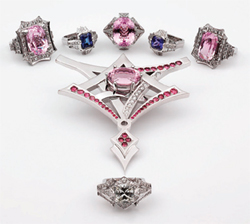|
The Beryl Family Beryl has six gemstones in its group, and is not to be confused with Chrysoberyl, which has three. Aquamarine, emerald and morganite are the three most common beryls; the others are bixbite, yellow beryl (heliodor) and clear beryl (goshenite). Different beryls obtain their differing colours from the presence of metallic elements, mixing with their basic beryllium and aluminium elements combined with varying amounts of In gemology, clarity is a must for the connoisseur but not so with emeralds. Why, I have no idea, as there are rarer gems with much greater clarity and beauty that do not get the recognition (or price!) of emeralds? In fact, with emeralds, an included deep coloured gem will command a greater price than a paler one of great clarity, and carat-for-carat emeralds can command higher prices than diamonds. But that’s not all, as they say! Most emeralds have been treated with waxes, oils and resins when being cut (cutting is a difficult and very slow process), and these treatments are not permanent. Most decent suppliers will disclose treatments, as it is frowned upon not to do so. However, if you want a beautiful, green, clear, hassle-free stone, look at garnets, such as demantoid or Tsavorite, green tourmalines, chrome diopside, chrysoberyl… the list goes on and on. Morganite is a fantastic gemstone and has gained rapidly in popularity and deservedly so. And the others? Bixbite is known as a red emerald. It is usually heavily included, making This gem deserves attention; it is hard enough for all jewellery and has a fantastic brilliance and fire - a scintillating gem. If you have any queries on gemstones or have any jewellery to be designed or made or refashioned, please call me. StrawberryWood StrawberryWood |
|
Upcoming Events
-
Rothwell Farmers Market
Saturday 20th April, 09:00 - 16:00 -
Mayor’s 90s Night
Saturday 20th April, 19:30 -
Shamblers Walk
Sunday 21st April, 13:30 -
Spring Bridge Drive
Tuesday 23rd April, 10:00 -
East Northants Association of The N...
Tuesday 23rd April, 19:30


